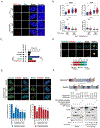RAD51AP1 Is an Essential Mediator of Alternative Lengthening of Telomeres
- PMID: 31400850
- PMCID: PMC6778027
- DOI: 10.1016/j.molcel.2019.06.043
RAD51AP1 Is an Essential Mediator of Alternative Lengthening of Telomeres
Erratum in
-
RAD51AP1 Is an Essential Mediator of Alternative Lengthening of Telomeres.Mol Cell. 2019 Oct 3;76(1):217. doi: 10.1016/j.molcel.2019.08.009. Mol Cell. 2019. PMID: 31585101 Free PMC article. No abstract available.
-
RAD51AP1 Is an Essential Mediator of Alternative Lengthening of Telomeres.Mol Cell. 2020 Jul 16;79(2):359. doi: 10.1016/j.molcel.2020.06.026. Mol Cell. 2020. PMID: 32679078 Free PMC article. No abstract available.
Abstract
Alternative lengthening of telomeres (ALT) is a homology-directed repair (HDR) mechanism of telomere elongation that controls proliferation in aggressive cancers. We show that the disruption of RAD51-associated protein 1 (RAD51AP1) in ALT+ cancer cells leads to generational telomere shortening. This is due to RAD51AP1's involvement in RAD51-dependent homologous recombination (HR) and RAD52-POLD3-dependent break induced DNA synthesis. RAD51AP1 KO ALT+ cells exhibit telomere dysfunction and cytosolic telomeric DNA fragments that are sensed by cGAS. Intriguingly, they activate ULK1-ATG7-dependent autophagy as a survival mechanism to mitigate DNA damage and apoptosis. Importantly, RAD51AP1 protein levels are elevated in ALT+ cells due to MMS21 associated SUMOylation. Mutation of a single SUMO-targeted lysine residue perturbs telomere dynamics. These findings indicate that RAD51AP1 is an essential mediator of the ALT mechanism and is co-opted by post-translational mechanisms to maintain telomere length and ensure proliferation of ALT+ cancer cells.
Keywords: RAD51AP1; SUMOylation; autophagy; cancer; homology-directed repair; telomere.
Copyright © 2019 Elsevier Inc. All rights reserved.
Conflict of interest statement
DECLARATIONS OF INTERESTS
The authors declare no competing interests.
Figures






References
-
- Bryan TM, Englezou A, Dalla-Pozza L, Dunham MA, Reddel RR, 1997. Evidence for an alternative mechanism for maintaining telomere length in human tumors and tumor-derived cell lines. Nat. Med. 3, 1271–1274. - PubMed
Publication types
MeSH terms
Substances
Grants and funding
LinkOut - more resources
Full Text Sources
Other Literature Sources
Molecular Biology Databases
Research Materials

